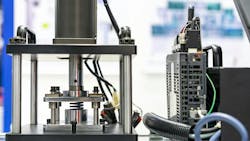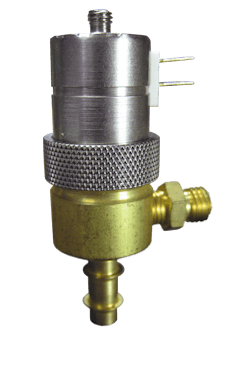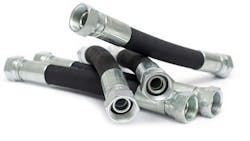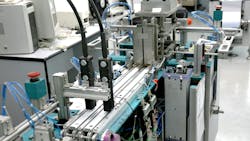Industrial Applications Require Smart and Efficient Fluid Power Systems
What you'll learn:
- Key features customers in industrial applications want from fluid power systems.
- How hydraulics and pneumatics are evolving to meet the requirements of various industrial applications.
- The industry trends driving the need for smarter and more efficient fluid power components and systems.
The inherent benefits of hydraulics and pneumatics, such as power density and speed, continue to make them the technology of choice in many industrial applications. But as these applications continue to evolve, so too do the fluid power systems utilized within them.
Today’s customers in the industrial sector are looking for fluid power products which can provide a wide range of features from built-in intelligence and connectivity to compact and efficient designs. Sustainability, automation and the desire to be more proactive about maintenance are some of the trends driving the need for these capabilities.
In this second part of a three-part Q&A series, members of the fluid power industry discuss the features customers in the industrial sector are looking for from their hydraulic and pneumatic systems as well as the trends influencing system designs.
Read the other two parts of our industrial fluid power Q&A series which highlight the benefits fluid power technologies offer various industrial applications and future opportunities for hydraulics and pneumatics.
Part 1: Hydraulics and Pneumatics Benefit a Range of Industrial Applications
Part 3: Opportunities Remain for Industrial Fluid Power Applications
Power & Motion: What are some of the key features customers in the industrial sector are looking for from the fluid power components and systems they will utilize in their machines?
Andrew Aurand, Director of Sales & Marketing, Clippard: Today’s customers are more sophisticated than ever. They are looking beyond just basic actuation. The key features they demand are:
- Intelligence and Connectivity: Customers want components that can communicate. They want to be able to get feedback from a valve or pressure sensor directly into their PLC (programmable logic controller) for process control and predictive maintenance. Our line of Cordis electronic pressure and flow controllers is a direct response to this need.
- Precision and Proportional Control: It’s no longer just about "on/off." Customers need to precisely control pressure, flow, and position. Proportional valves that can accurately modulate output based on an electronic signal are in high demand for applications ranging from leak testing to medical gas blending.
- Energy Efficiency: With rising energy costs and sustainability initiatives, customers are highly focused on minimizing compressed air consumption. This means they are looking for low-leakage valves, properly sized components, and intelligent systems that can reduce pressure during idle periods.
- Miniaturization: As machines and devices become smaller and more complex, the components inside them must follow suit. Customers need smaller, lighter components that still deliver the required performance. This has been Clippard's core competency since our inception.
Jacob Paso, President, Delta Motion: In precision hydraulic motion control, motion cylinders with low-friction seals, high-performance servo or proportional valves, and precise position, pressure, and force sensors are all critical components. They often need to be robust and handle shock and vibration to be components of a successful system. And, of course, a motion controller that is easy to use and designed for the complex needs of hydraulics. All of these components need good, responsive support from the manufacturer.
Cindy Cookson, VP & GM, Fluid Power Americas, Gates Corp.: Customers want solutions that are lighter, easier to install, compact, and safe. Gates’ fluid power portfolio is built with these needs in mind: lighter hoses that improve ergonomics and efficiency, faster-to-install designs that reduce downtime, and more compact options that solve routing challenges. Just as importantly, our matched systems — hoses and couplings designed to work together — deliver the safety and reliability customers depend on.
Michelle Gladysz, Product Line Manager – MFB Valves, Moog Industrial Group: The power efficiency — the amount of force that you can get out relative to the power (current or voltage) that you put into a system — that you can get out of a hydraulic system is often greater than for electric systems. In cases where we really want an efficient system, where we get a maximum amount of power out, that [provides] a lot of value, especially in the power generation and turbine industry. We can also typically get a higher level of precision, especially when we talk about pneumatics. But even in some of those smaller hydraulic applications, we can control very precisely a system without putting as much energy and bulk of equipment in as with an electrical system. So, I think those are two of the key elements.
If we look at a lot of the industries, such as test equipment, that are using hydraulics still, some of it is [because] it's a simple solution in that if we've got a hydraulic system supply readily available, it's the easiest solution to get a force out or to get that detailed control. Whereas, if you were to try to design the same kind of system with electric controls, it tends to become a little bit more complicated — more software and detailed control systems are required — compared to a little more straightforward type of technology such as hydraulics.
There are some applications, like sawmills, where there is a desire to have something standard and an almost analog system that is easy to control and easy to understand. They don’t necessarily need all the bells and whistles in those types of facilities. They just need a reliable, efficient power source or efficient force system; that’s really where hydraulics and some of our hydraulic control valves can really thrive.
Dan Detweiler, Value Added Systems and Technical Services Manager, Parker Hannifin: Competitive price, reliable delivery, global after sales support, simplicity in design, excellent quality and reliability of components. The ability to support IoT (Internet of Things) solutions where applicable continues to expand in popularity. Highly experienced hydraulic maintenance technicians are less common, so simple designs in hydraulic systems are increasingly important. From our experience, customers want durability and efficiency more than anything. Because maintenance and down-time are so expensive, they want something they know will work. I believe smart products and great documentation are also very desirable but are somewhat secondary.
Shalom Kundan, Division Marketing Manager, Parker Hannifin: Customers are increasingly looking for key benefits, with pneumatic technology offering key differentiating factors to end-users, namely:
- Energy efficiency (low-leakage valves, air preparation improvements, smart FRLs [filter regulator lubricator]).
- Connectivity and data (sensors and IO-Link/IIoT-enabled devices for predictive maintenance).
- Compact and modular design to save space and simplify installation.
- Reliability and durability in demanding environments.
Power & Motion: What major industry trends, if any, are influencing the design of hydraulics and pneumatics for industrial applications?
Andrew Aurand, Clippard: The most significant trend is undoubtedly connectivity and intelligence. This is the driving force behind the demand for "smarter" components. We are designing valves and pressure controls with integrated electronics that provide diagnostics, cycle counts, and real-time performance data. This allows machine builders to offer predictive maintenance alerts to their customers, reducing unplanned downtime.
Another major trend is the simplification of integration. Customers want plug-and-play components. This influences our design of valve manifolds, which come pre-assembled, tested, and wired, drastically reducing assembly and commissioning time for the OEM.
Finally, sustainability is a powerful driver. This is pushing us to develop more energy-efficient products that use less power and minimize compressed gas usage.
Jacob Paso, Delta Motion: For some time now, efficiency requirements have been driving increased use of direct-drive cylinder control, where a servomotor drives a hydraulic pump that directly controls the cylinder, instead of using a servo or proportional valve. These systems are not a good fit for every application because a motor and pump don’t respond as quickly as a valve and the systems generally have more hysteresis.
More often, direct-drive control is being used in HPUs (hydraulic power units) with a servo or VFD (variable frequency drive) controlled motor driving a fixed-displacement pump, providing some energy savings over a swash-plate pump.
The need for increased data and reduction in cable cost has been increasing interest in fieldbus connections such as EtherCAT from the motion controller to the hydraulic valves, cylinder position sensors, and pressure sensors. Mobile hydraulics has long done this via CANbus, but industrial hydraulics has less need of reduced cabling and has been slower to adopt. Industrial hydraulic motion control often requires higher bandwidth than CANbus provides, meaning higher performance communication with associated higher cost.
Cindy Cookson, Gates Corp.: One of the biggest shifts we’re seeing is the need for more compact systems. As industrial equipment becomes tighter and more complex, routing hydraulic hose assemblies reliably in constrained spaces is a growing challenge. Customers are also asking for greater customization and the kind of high-reliability, low-failure products that minimize downtime.
Alongside these performance demands, sustainability continues to be top of mind throughout the industry. And they’re starting to zero in more and more on the whole life cycle of their equipment, not only with the hoses but also the couplings. Gates’ MXT and MXG hoses, for example, are 30% lighter than comparable products, reducing material use, cutting transport emissions, and lowering waste at end of life thanks to longer service life. Together, these trends are shaping the next generation of hydraulic design.
Michelle Gladysz, Moog Industrial Group: We have digitally controlled hydraulic valves…that combine the best of both worlds in some instances in that we are able to incorporate more sophisticated digital control that gives users more flexibility so that they're able to fine tune some of the features on their valves if they need in the field, and maybe adjust some of the specific controls and performance [aspects] and integrate them into a more advanced overall system. There has definitely been a trend over the years to move towards those digital features. Certainly that comes at a cost, though, so there's still a steady demand in the background for the more basic analog versions as well.
Overall, when we look at that kind of industry trend, I think it's a very gradual shift. It's a gradual movement towards incorporating digital features and digital control elements into hydraulics. But [there is] a gradual trend in that direction. There is a trend in some industries towards a reduced size and reduced envelope, such as robotics and undersea exploration, some of those newer applications and fields need to have a smaller size [component]. So, there is some development there and opportunity for our smaller valves to fit some of those needs.
Watch our video interview below to learn more about the technologies enabling digitalization of fluid power systems.
Dan Detweiler, Parker Hannifin: Industrial electrification which provides efficient hydraulic power and noise reductions. Variable frequency AC drives (drive controlled pump technology) continues to expand its footprint in the industrial market based upon its efficiency, smaller footprint, and low noise characteristics when compared to traditional HPUs. Noise reduction was the most appreciated benefit to this technology, but increasing concerns expressed by the end uses with energy costs are becoming a greater factor for the machine builders. Many designers are adding sensors and transducers to enable IoT solutions and support predictive failure strategies. In some cases the manufacturers are now adding these devices directly into the component design.
Machine builders must keep their users in mind when designing machines. Simpler designs that are easy to commission, troubleshoot, and maintain to provide high machine up-time [is necessary]. The shift of technology more towards electrical actuators where they can be applied means that fluid power controls are being changed and hybrid technologies such as proportional hydraulic valves which are electrically controlled are gaining popularity.
Shalom Kundan, Parker Hannifin: With the advent of artificial intelligence and the continuous proliferation of automation technologies in Industry 4.0, several trends standout:
- Electrification & digital integration: Pneumatics are being designed to integrate seamlessly with electronic controls, enabling hybrid solutions.
- Sustainability: Lower compressed air consumption and energy efficiency are shaping product innovation.
- Automation growth: Increased use of collaborative robotics and flexible manufacturing requires lighter, modular, and reconfigurable pneumatic systems.
- Smart pneumatics: Embedded diagnostics and connectivity for predictive maintenance.
John Fenske, Director of Marketing, Tolomatic: Information and connectivity are critical — especially for industrial customers operating in high-volume production environments. Having real-time visibility into machine and process performance enables faster, data-driven decisions that optimize productivity and enhance quality.
About the Author
Sara Jensen
Executive Editor, Power & Motion
Sara Jensen is executive editor of Power & Motion, directing expanded coverage into the modern fluid power space, as well as mechatronic and smart technologies. She has over 15 years of publishing experience. Prior to Power & Motion she spent 11 years with a trade publication for engineers of heavy-duty equipment, the last 3 of which were as the editor and brand lead. Over the course of her time in the B2B industry, Sara has gained an extensive knowledge of various heavy-duty equipment industries — including construction, agriculture, mining and on-road trucks —along with the systems and market trends which impact them such as fluid power and electronic motion control technologies.
You can follow Sara and Power & Motion via the following social media handles:
X (formerly Twitter): @TechnlgyEditor and @PowerMotionTech
LinkedIn: @SaraJensen and @Power&Motion
Facebook: @PowerMotionTech

Leaders relevant to this article:




